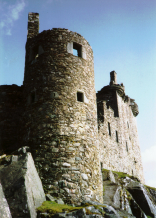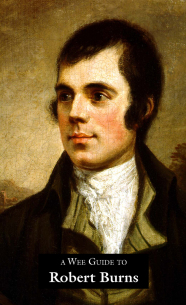Robert Burns: The Land and the City
The brief life of Robert Burns was but a handspan in the second half of the eighteenth century. He died before he was 40 years old, his health broken by the hard physical labour of a boyhood spent doing a man’s work on his father’s farm. Yet in those years Burns not only witnessed great revolutions abroad – in America in 1776, in France in 1789 – but lived through a revolution at home in every way as turbulent.
This revolution had its roots, quite literally, in the land: who owned it and how, what it yielded, and how much, and by what means. Burns was born into a Scotland still farmed as a peasant culture: the laird (or landowner) owned the land outright, and his tenants farmed it for his benefit and the benefit of his heirs. In return for a lifetime of loyalty and hard work, they could take what they needed for their families: a roof over their heads, and enough land to cultivate food to put in their children’s mouths. It was a life lived on the edge of enough: any surplus must of right belong to the landowner; any less – the result, for example, of a bad harvest or pestilence among animals – and the family would fall through the fragile net of sufficiency into the pit of poverty which lay unforgivingly beneath.
When Burns was born, the land was not fenced or walled. Visitors who look at the neat parcelled fields of Ayrshire today are looking at an order created during Burns’ lifetime – as a boy, he would have looked upon unfettered open space where it was accepted that land was owned by one but used by all: in fact, a commonwealth of rough grazing. Each man took from it what he needed: peat or timber for fuel, grazing for his animals, and a patch of soil round his cottage for food.
The revolution that transformed the countryside of lowland Scotland from open muir – or meadow – to enclosed farmland came about as the old order creaked and collapsed under the burdens of the new: the population explosion which began during the eighteenth century meant more babies certain to survive into adulthood, more mouths demanding more food, larger towns and cities hungry for produce, and an agricultural hinterland which needed to move, almost overnight, from peasant economy to an efficient producer of abundant surplus. With the urgent need to improve the quality of land came the need for lime, and lime needed transportation: the Turnpike Acts of 1766 and 1774 began the irrevocable process of transforming rough bridlepath into major highway down which crime and disorder could travel as fast as food and culture.
The Scotland into which Burns was born was essentially two cultures in one nation: Highland and Lowland. It has been observed that the citizens of Edinburgh and the market-minded Lowlander felt more in common even with the English than with the Highland society and culture of fact and legend.
The Battle of Culloden, that Hanoverian killing spree which placed a bloody fullstop on the Jacobite uprising of 1745-6, was well within living memory and that memory a bitter one. The Highlander became a hunted creature: what the sword and the fire of Hanoverian armies failed to do in 1746, subsequent years of harsh legislation achieved. Some Highlanders had already taken ship for the New World or for Australia. The 1707 Act of Union between the parliaments of England and Scotland came to be seen for what it was: the suffocation of the Scots identity by a heavy-handed government hundreds of miles away in London.
The capital city, Edinburgh, where Burns lived for two years, was consolidating its reputation as the Athens of the North. For hundreds of years, the city had huddled in diseased and insanitary squalor around and below the castle walls. Rich and poor lived side by side – or more accurately, on top of one another in high tenements, some of them 14 storeys – called ‘lands’. Into every available inch of space they crowded, the class structure made manifest by the floor you inhabited: clerks and menial workers on the lower levels, the wealthy in the middle, the merchants just above them with a few more stairs to climb – those middle classes thus forming a buffer between the rich and the poor, who lived under the stars at the very top. The smell was overpowering: toilet slops were ritually emptied from the windows at 10pm, and it was remarked that Edinburgh by night was ‘perilous underfoot’.
By 1772, however, the great exodus of the rich across the Red Sea of Princes Street had begun. George Street and Queen Street were under development and graceful buildings reached towards the village of Stockbridge. From their plum-red, rose-pink, or sea-green drawing-rooms in the New Town, adorned with fireplaces by Adam and furniture by Chippendale, the rich could look up at the castle against the skyline, and reflect on the real distance they had travelled. Lawyers, bankers, merchants, physicians and intellectuals, the pride of
Edinburgh society rested on the right choice of school, of profession and of church. Adam Smith wrote The Wealth of Nations here: but Edinburgh could still claim a variety and richness of life. In the bawdy taverns of the Grassmarket business was thriving, and when Burns was in Edinburgh, the colourful saga of Deacon Brodie was drawing to a close.
William Brodie – inspiration a century later for Dr Jekyll and Mr Hyde – was by day a respected city councillor and pillar of society; by night, a thief and a gambler with loaded dice. Brodie was caught and hanged on 1 October 1788 from the city’s new ‘humane’ drop-gallows – gallows which ironically he himself had commissioned as being more merciful than the older custom of turning victims off a ladder. In one of his very worst poems, Burns saluted Edinburgh as
Edina! Scotia’s darling seat ...
(It must be noted that many years later one of the first manufacturers of toilet bowls used the trade-name Edina for their product. This seems fittingly ironic in view of Edinburgh’s previous reputation as an open sewer.)
South of Edinburgh and Glasgow, the Lowland counties prospered by farming. A man might pursue another trade such as shoe-making or inn-keeping, but there was often a farm to tend as well. Farming and the land were absolutely interwoven into the fabric of everyday life. Even so, the eighteenth-century Lowland Scot had a level of education that was second to none, and literacy levels were impressively high. The Education Acts of 1649 and 1696 required each parish to provide a school.
Society loves to hang labels on people – and all too often hang them by their labels. When Robert Burns rode to Edinburgh in 1786, hot with the success of his first published verse, elegant society lionised him as ‘the Ploughman Poet’. They loved the – patronising – idea of a rough, scarcely educated boy, ignorant of the manners of the drawing-room, the dinner table or the lady’s boudoir, shivering in the mud behind his plough in Ayrshire and plucking warm verse from the frozen air.
Burns used this image as far as it was to his advantage but was quick to see through the falsity of the society which created it. His genius may have been a gift from the gods, but he cultivated it as assiduously as he cultivated the stony, meagre earth he farmed. He was by no means uneducated – a veneration for education is an integral part of Scots culture, and Burns’ father contrived for his sons as solid an education as was possible. Burns at 13 – the age by which any formal education had ceased – was arguably better (and more enthusiastically) educated than many an upper-class counterpart in expensive private schooling.
In the drawing rooms of the rich he conducted himself with an ease and a steady gaze that some found offensive. And he spent only two years in what he called ‘the noise and nonsense’ of Edinburgh before returning to where he felt most himself – the land.
In the best of his poetry, Robert Burns used the Scots language to record and to honour this unique heritage: he expressed and embodied the very contradictions of his native country – blood and sophistication, murder and magic, roughness and civility. The hand that steadied a plough also scratched lines of verse on glass – with a diamond.
© Dilys Jones and Martin Coventry 2018









